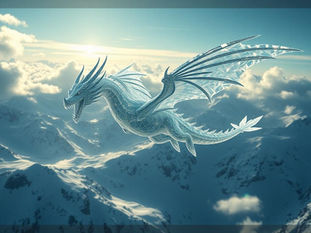
Boosting Your Midjourney Videos: Raw Versus Standard Modes Explained
Jul 28
5 min read
0
17
0

Creating compelling videos with Midjourney involves understanding its core settings. This guide looks at two key modes for Midjourney video creation: Standard and Raw. We will break down what each mode means and how they change your video results. We will also see how the quality parameter `--q4` affects your final video output.
Understanding Midjourney Video Modes
Just like with images, you can open Midjourney's settings panel. Look for the icon that lets you change settings. Once there, find the section called `model`. Inside, you can pick either `Standard` (which is the main setting) or `Raw` mode. The mode you pick stays active until you change it again, whether you are making an image or a video.
You can also quickly switch to Raw mode for a single prompt. Just add `--raw` to your prompt. This will override your current setting without you needing to go into the full settings menu.
Standard Mode: The Core Setting
Standard mode uses Midjourney’s usual style settings. It often leads to outputs that have a distinct Midjourney look. This is the default choice when you start creating anything.
Raw Mode: For a Natural Feel
Raw mode gives you results that look more natural and less "styled" by the AI. This can be great for videos where you want movements and details to appear more realistic. It aims for a more direct interpretation of your prompt without adding as much artistic flair from Midjourney. You activate it by selecting it in your settings or by adding `--raw` to your prompt.
Seeing the Modes in Action: Examples
To begin making a video, drag an image into the starting frame field, or click on an image you want to use. Then, choose the motion level you want. For these tests, we used different images with varying levels of detail and applied different motion options. The initial prompts and motion levels stayed the same for each image to show the differences clearly.
[HUL]
[LI]Top left: low motion[/LI]
[LI]Top right: high motion[/LI]
[LI]Bottom left: low motion with raw[/LI]
[LI]Bottom right: high motion with raw[/LI]
[/UL]
Fantasy Scene: Dungeons & Dragons
In a scene set in a fantasy world, four heroes stand on a bridge before a large castle. A strong dragon flies in and lands on a tower. All four video versions look good and keep a consistent style. The scale and lighting feel real. Both Standard and Raw modes produce strong visuals in this case.
Playful Puppies: Showing Raw Mode's Strength
Next, we have five small puppies playing together. Here, Raw mode really shows its advantages. The dogs move in a more lifelike way, and their actions look very real. While the Standard versions are also well made and fun to watch, Raw offers that extra bit of natural movement.
Desert Warrior: Capturing Movement
Imagine a lone warrior walking across a vast desert of dust and spice. Raw mode captures the natural movements of people a bit better here. This example was made using auto mode, so there was less specific control over how it turned out, yet Raw still shines through.
Forest Creature: Realistic Feels
We visit a Canadian forest where a friendly creature finds its favorite drink. All versions look good. What stands out is that Raw mode gives the video a slightly more real feel again. It adds to the immediate perception of reality in the scene. If you find yourself spending too much time fine-tuning these settings, consider powerful tools that can help. The Midjourney Automation Suite from TitanXT can help you manage your settings and tests more efficiently, saving you time and effort and allowing you to focus on your creative vision.
Challenging Scenarios: Titanic & Orc
Some ideas are harder to make. In an example with a ship meant to be the Titanic, the original image looked too much like an old 3D graphic. The videos, both Raw and Standard, ended up looking flat and uninteresting. This shows that the original image strongly impacts the final video output.
Another tricky example involved a warrior looking at their reflection in a sphere. The idea was that when touched, the sphere would activate, showing digital eyes. Midjourney seemed to make the warrior look like plastic because of the sphere's material. This means the AI might interpret details in unexpected ways based on the source image elements.
From these tests, we can conclude a few things:
Auto-mode often gives unpredictable results, while manual mode lets you keep some creative control.
High motion generally feels more active, but sometimes low motion can appear more dynamic, so results vary.
When comparing Standard and Raw, the starting image has the biggest effect on the video. Raw often adds more realism to movements, as seen with the friendly forest creature and the puppies.
The Quality Parameter (--Q4) and Video Output
Many wonder if using `--q4`, which gives the highest quality image output, also affects video creation. It is true that better source images usually lead to better video results in Midjourney. This means when your starting image has more detail in lighting, shapes, and overall look, this naturally appears in your video as well. Put simply, the more visual information Midjourney has to work with, the better it can process and create a good video.
When comparing two source images, one with `--q4` and one without, the `--q4` version is clearly better. It has richer material, better lighting, and more detail. The version without `--q4` appears rough in comparison.
Now, looking at videos made from these images with a camera rotating around a shoe, the video from the `--q4` image shows a subtle improvement. The average viewer might not notice this quickly, but these small differences can turn a good video into an excellent one.
Keep in mind that using `--q4` takes longer to create images, and this uses up your fast hours. Midjourney’s help desk notes that the quality parameter only affects the first set of four images you get. It does not change later versions, inpainting, outpainting, or upscales. `--q4` is an experimental option in Midjourney version 7. It can provide better details and consistency but is not compatible with other specific commands.
To make the most of your Midjourney workflow and ensure you get the best outcomes, consider a tool that can streamline the entire process. The Midjourney Automation Suite from TitanXT helps automate your image and video creation, allowing you to focus on creativity rather than manual adjustments. It is built to make your Midjourney experience smoother and more effective.
Choosing between Raw and Standard mode depends on the type of look you want for your videos. Raw mode often helps with more natural movement, while Standard mode gives you Midjourney’s usual style. Always remember that a high-quality starting image gives Midjourney better material to work with, leading to better video results.






